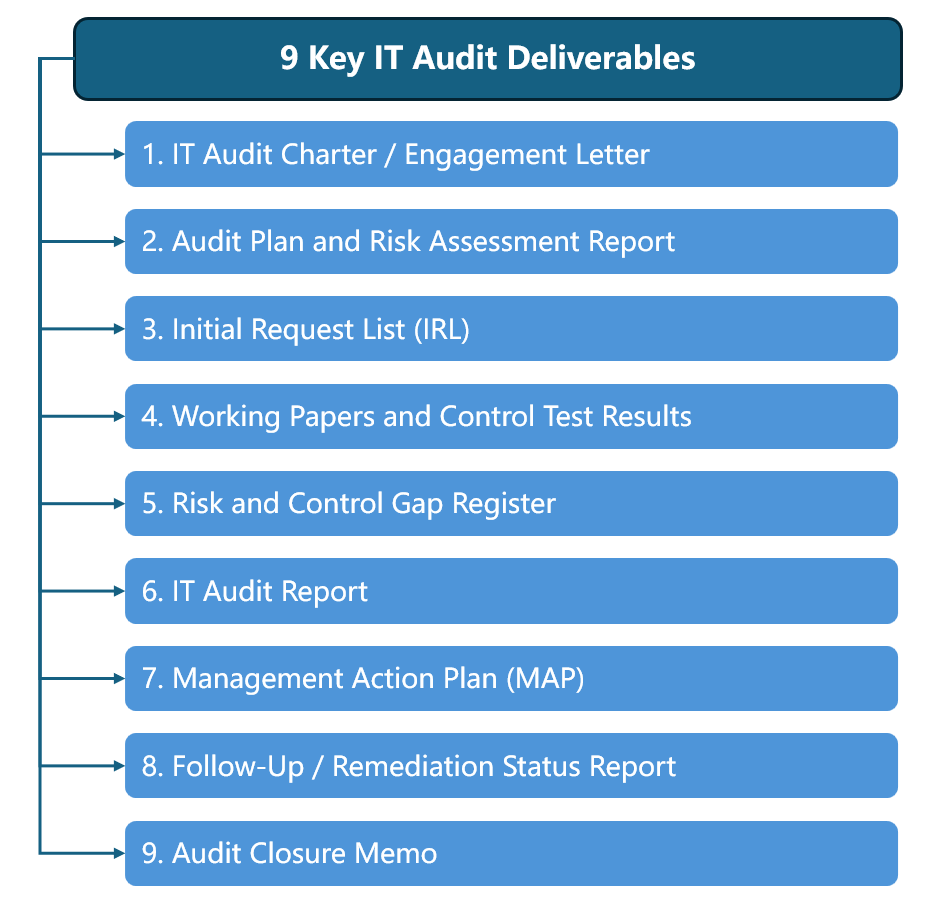Introduction of IT Audit Deliverables
IT Audit Deliverables are the formal documents, reports, working papers, and evidence that an auditor produces during and after the audit process. These deliverables provide:
- Documentation of audit scope, methodology, and findings
- Evidence of control testing and issue validation
- Actionable insights and recommendations for remediation
- Proof of audit quality and regulatory compliance
They ensure that audit stakeholders—including IT, risk management, compliance officers, audit committees, and external regulators—have a clear and reliable reference for current risk status and required actions.
9 Key IT Audit Deliverables

📘 1. IT Audit Charter / Engagement Letter
Purpose: Formal agreement defining the purpose, authority, and responsibilities of the audit.
Contents:
- Audit objectives and scope
- Responsibilities of audit and auditee
- Reporting lines and timelines
- Legal and compliance context
Timing: Issued before the audit begins (during planning).
🧭 2. Audit Plan and Risk Assessment Report
Purpose: Define how the audit will be performed and identify key risk areas.
Contents:
- Scope of systems and controls under review
- Audit timeline, phases, and resources
- Preliminary risk assessment and control mapping
- Audit universe and coverage rationale
Timing: Early-stage deliverable; serves as blueprint for audit fieldwork.
📋 3. Initial Request List (IRL)
Purpose: Collect documentation and access permissions necessary for the audit.
Contents:
- List of required policies, procedures, logs, access credentials, and evidence
- Due dates and responsible parties
- Tools or systems to be accessed
Timing: Sent prior to fieldwork or testing phase.
📂 4. Working Papers and Control Test Results
Purpose: Document the detailed evidence and results of control design and effectiveness testing.
Contents:
- Control objectives and test steps
- Sample selections and results
- Evidence (screenshots, logs, configs)
- Auditor conclusions and exceptions found
Tools: Excel, GRC platforms, internal audit portals
Timing: Created during fieldwork phase and continuously updated.
📉 5. Risk and Control Gap Register
Purpose: Summarize identified deficiencies, their severity, root causes, and impact.
Contents:
- Gap ID, description, and affected control
- Risk severity rating (High, Medium, Low)
- Impact (financial, operational, compliance)
- Root cause and business owner comments
Timing: Post-testing, used to inform reporting and remediation planning.
🗂 6. IT Audit Report
Purpose: Present the audit’s formal findings, risks, and recommended actions to management and stakeholders.
Contents:
- Executive summary
- Background and scope
- Audit methodology
- Observations and risk ratings
- Recommendations and management responses
- Conclusion and overall audit opinion
Audience: CIO, CISO, Risk Committee, Board, External Auditors
Timing: After analysis phase, typically 1–2 weeks post fieldwork.
📜 7. Management Action Plan (MAP)
Purpose: Define the corrective actions that will be taken for each audit finding.
Contents:
- Finding reference
- Action items
- Responsible person
- Deadline
- Risk owner approval
Timing: Submitted by auditees after audit report is reviewed.
📆 8. Follow-Up / Remediation Status Report
Purpose: Track progress of remediation efforts and verify issue closure.
Contents:
- Status of each MAP item (Not Started / In Progress / Completed)
- Updated timelines and responsible owners
- Evidence of remediation
- Auditor re-validation (if applicable)
Timing: Quarterly or bi-annual follow-up reports; sometimes followed by re-audit.
🧾 9. Audit Closure Memo
Purpose: Official documentation that the audit has been completed and all deliverables are finalized.
Contents:
- Summary of objectives and scope
- Key findings and actions taken
- Stakeholder acknowledgements
- Date of closure
Timing: Final administrative step after follow-up is completed.
🧷 Summary Table of IT Audit Deliverables
| Deliverable | Purpose | Produced During |
|---|---|---|
| Audit Charter / Engagement Letter | Define audit authority & objectives | Planning |
| Audit Plan & Risk Assessment | Outline audit scope & priorities | Planning |
| Initial Request List (IRL) | Request documentation & access | Pre-Fieldwork |
| Working Papers & Test Results | Evidence of audit tests & results | Fieldwork |
| Risk and Gap Register | Summarize issues and risks | Analysis |
| IT Audit Report | Communicate findings & risks | Reporting |
| Management Action Plan (MAP) | Define remediation steps | Post-report |
| Follow-Up Status Report | Track and validate remediation | Follow-up |
| Audit Closure Memo | Officially close audit | Closure |
✅ Best Practices for Managing IT Audit Deliverables
- Version Control: Use audit platforms (e.g., TeamMate, AuditBoard, or OneDrive with naming conventions) to ensure deliverables are tracked.
- Standardization: Use pre-approved templates to ensure consistent documentation across audits.
- Audit Trail: All deliverables should be backed by logs, evidence, timestamps, and reviewer notes.
- Confidentiality: Ensure deliverables containing sensitive information are encrypted and access-restricted.

- A Comprehensive Guide to IT Audit: Purpose, Frameworks, Processes, and Best Practices
- IT Audit Guide 01: What Is IT Audit? Why IT Audit Matters?
- IT Audit Guide 02: Why and When to Conduct IT Audit?
- IT Audit Guide 03: Common IT Audit Frameworks
- IT Audit Guide 04: Scope and Content of IT Audit Work
- IT Audit Guide 05: IT Audit Process (Step-by-Step Guide)
- IT Audit Guide 06: IT Audit Templates and Checklists
- IT Audit Guide 07: IT Audit Deliverables
- IT Audit Guide 08: IT Audit Best Practices

